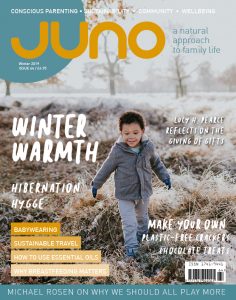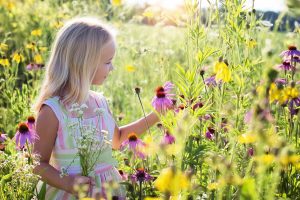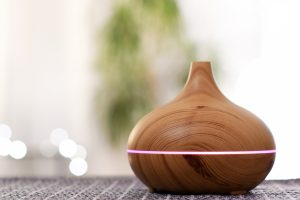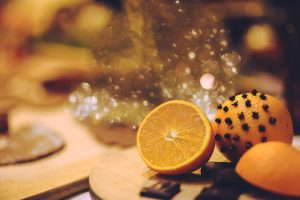Heather Dawn Godfrey explains how all of the family can enjoy using essential oils
This article was published in Juno Magazine’s 2019 Winter edition.

Subscribe online at www.junomagazine.com
The article below includes excerpts from my new book, Healing with Essential Oils (Inner Traditions, Bear & Co.)
Winter Scents
Scents for winter and the festive season! Mmmmm…Immediately my ‘inner nose’ catches wisps of spicy mulled wine carried on a pine infused breeze, oranges spiked with cloves, the sweet warm smell of nutmeg and cinnamon rising from freshly baked fruitcake. The potent connection between scent and memory, my imagination imbues my senses, and I feel a sense of earthy warmth and joy.
There are so many ways essential oils can be applied to create powerful poignant aesthetic scenes. But even more than this, essential oils possess potent therapeutic anti-microbial, skin healing, and psycho-emotional properties: qualities that are supported by substantial research evidence.
There is no doubt that essential oils are sensually pleasant and fun to use.
However, I am compelled to pause here for a moment to share a word of caution. Natural does not mean ‘safe’. As with all things in nature, we have learnt there are rules, and as lovely as they are, essential oils are not exempt.
Essential oils are, in fact, highly concentrated volatile aromatic distillates, isolated from various parts of certain plants and trees: for example, heartwood, bark, roots, resin, leaves, twigs, stalks, flowers, fruits and seeds.
Did you know:
- two pounds of lavender produces ten millilitres of essential oil
- One drop of essential oil is equivalent to fifteen to forty cups of medicinal tea or up to 10 teaspoons of tincture?
In the plant, essential oils are present in very small amounts, alongside other phyto-chemicals that synergistically quell and counterbalance irritant or toxic components, and positively balance and potentiate others. Isolated from their plant source, many of the non-distillable molecules are left behind; the extracted volatile essential oil molecules are condensed and their collective synergistic ‘fingerprint’ consequently alters.
The chemical composition of an essential oil also changes over time through a process known as oxidisation; some molecules evaporate, some transmute, with various consequences, some of which are valuable, even enhancing, and some of which, conversely, degrade the quality of an essential oil, rendering it more irritant or even toxic.
The term essential ‘oil’ is misleading. Essential oils are not ‘oily’. When applied neat, essential oils are, in fact, drying to mucous membranes and irritate organs of the digestive system when consumed orally; they also exacerbate water loss from skin, causing a drying and potentially irritating effect. Thus, essential oils are always added to an emollient, such as vegetable oil, cream, lotion, gel or ointment. Vegetable oils slow down water loss. Water-based creams and lotions aid absorption. When prescribed by medical practitioners for internal use, a very small amount of essential oil is dispensed in gel-like capsules in controlled amounts.
 Children and Essential Oils
Children and Essential Oils
Children are more vulnerable than adults to environmental and topical chemicals, substances and microbes.
A baby’s skin is just one-fifth the thickness of adult skin, and does not fully mature until they are six years old. Thus the barrier function of infant skin is compromised and is more susceptible than adult skin to chemical and microbial infiltration, especially at birth and during the first three months of life. Substances easily penetrate surface tissues and quickly pass to the lower layers of the dermis. Also, while infant skin holds more water than adult skin, this quickly evaporates, so their skin is prone to dryness and is easily irritated. Essential oils exacerbate this process. Also, an infants organs of elimination are less able to process essential oil molecules, increasing the risk of neurotoxicity. Pregnant women are susceptible too: not only due to increased sensitivity, but also because essential oil molecules cross the placenta and the blood-brain barrier.

As we previously established, most essential oil molecules will inflame or irritate a sensitive respiratory tract. Therefore, care must be taken when vaporising essential oils around babies, children, or those who suffer with asthma or respiratory disease. Essential oils must be vaporised some distance from a child’s headspace to avoid the risk of irritating their breathing airways and throat.
My advice is not to apply essential oils, even in dilution, to infants under three years old. Between three and six years, certain essential oils (see below) can be applied topically in very high dilution (one drop of essential oil in twenty millilitres of a carrier medium).
Essential oils to avoid for infants and young children (because they may be toxic or irritant), include peppermint and other herbaceous oils, also oils extracted from citrusy plants and fruit (with the exception of mandarin in high dilution), seeds, herbs, spices, and sensitising florals such as ylang ylang, oils that contain citral, such as lemongrass and citronella, and oils that influence the hormonal system, such as rose, among others. Oral ingestion of essential oils is out of the question.
Room diffusers (some distance from a child’s headspace) are the safest way to use essential oils for children.
Some essential oils that are safe for children over three years old (one drop of essential oil in twenty millilitres of vegetable oil, or two or three drops in a room diffuser) include: chamomile Roman, lavender and mandarin.
Vegetable oils can be applied without essential oils. They protect and soothe skin and exhibit valuable healing qualities of their own. For example, sunflower oil, massaged into the skin of premature babies three times a day, was found to enhance barrier function and thus to support immunity (with forty-one percent reduction in incidences of sepsis). (LeFerve et al 2010). Other useful vegetable oils include jojoba, safflower, and evening primrose.
Store essential oils in a cool dark place, with lids tightly secured, away from the reach of children. Ensure your bottle of essential oil has a dropper cap (this aids measurement, but importantly prevents children from drinking the oil). Wash any essential oil residue from your hands to avoid irritation and potential contact with your eyes.
(Godfrey 2022)
 ‘Grown up’ time
‘Grown up’ time
Of course, the essential oils are wonderful for grown ups too, and offer great remedies for tiredness, insomnia, low mood, ‘brain fog’, lethargy, and much more.
The following blends are examples of aesthetic scents that can be diffused to create a particular ambience – in this instance, Festive Winter. These blends include very strong, potent, anti-microbial oils, so are also useful environmental sanitisers, or ‘bug busters’.
However, strong anti-microbial essential oils are also very irritating to skin and mucous membrane, so should not be applied topically to skin, and must be diffused away from an infant’s headspace (or better still, in another room, or when children are in bed).
There is an argument that over-sanitizing, even with natural products, can actually have a negative effect on the immune system, especially for children who need some exposure to microbes to develop natural resistance.
It’s amazing how little essential oil is required to create an ambient effect. I find that just one dose of these oils is enough to leave a lingering ambient wisp of scent in the air sometime after the diffuser is switched off (electric diffusers are safer than candle lit ones around children).
Stop using these oils if you notice any irritation to your eyes or nose. As a caution, if you are pregnant, avoid contact with cinnamon leaf, cedarwood, cypress, and myrrh.
You can adjust the ratio of drops of essential oil you add to your blend – but use no more than six to eight drops in total. I actually find that one drop of each spice oil is sufficient; you can refresh these when and if necessary, thus you also have more control over scent intensity. Add the drops to your diffuser.
Festive Mull
1 drop clove bud
1 drop cinnamon leaf
2 drops bitter orange
(Uplifting and stimulating, easing mental and emotional fatigue)
Northern Forest
2 drops cedarwood atlas
2 drops pine
2 drops cypress
(Calming and sedative, yet refreshing, instilling feelings of peace)
Three Kings
1 drop myrrh
1 drop frankincense
1 drop orange bitter (well, orange is nearly gold)
(Calming yet revitalising, aids meditation and a sense of ‘spiritual self’)
Essential oils are wonderful versatile wellness and wellbeing tools. Their greatest attributes are their psycho-emotional-spiritual, anti-microbial, and skin healing qualities. But like all things natural they have their limits and must be applied with careful consideration. Appropriately applied, essential oils offer a veritable natural pharmacopeia. They are both practical, and sensually very pleasant; their scents ignite a spectrum of colourful nuances that whisper beautiful melodies to the heart and soul; they repair, restore, revitalise and replenish.
You will find much more about the qualities, uses and application of essential oils and carrier mediums in my latest book, Healing with Essential Oils (see, for example, Chapter’s Five and Six), and Essential Oils for the Whole Body, which includes chapters about creating blends, how to create your own creams and lotions, and more. Essential Oils for Mindfulness and Meditation identifies oils that encourage deep relaxation, and aid focus and concentration, and describes how the properties and qualities of essential oils support meditation, and promote a sense of feeling grounded yet uplifted.
References:
Bridges L. Risk v. Benefit: Using Potent Antimicrobial Essential Oils With Children. Tisserand Institute. https://tisserandinstitute.org/antimicrobial-essential-oils-children/ 2017
Godfrey H. Healing with Essential Oils. Healing Arts Press, Inner Tradition USA 2022
Godfrey H. Essential Oils for the Whole Body. Healing Arts Press, Inner Traditions USA 2019
Godfrey H. Essential Oils for Mindfulness and Meditation. Healing Arts Press, Inner Traditions 2018
Krumbec E. When not to use essential oils: essential oils can cause seizures in kids. Naturopathics.com. https://naturopathicpediatrics.com/2014/09/08/essential-oil-safety-danger-essential-oils-seizures-children/
LeFevre A, Schillcutt SD, Saha SK, et al. Cost-effectiveness of skin barrier-enhancing emollients among preterm infants in Bangladesh. Bull World Health Orgaon. 2010: 88(2) 104-112
Oranges T, Dini V, Romanelli M. Skin Physiology of the Neonate and Infant: Clinical Implications. Adv. Wound Care (New Rochelle) 2015 4(10): 587-595. https://www.ncbi.nlm.nih.gov/pmc/articles/PMC4593874/
Simon K.A., Hollander G.A., McMichael A. Evolution of the immune system in humans from infancy to old age: Proc Bio Science. 2015 282(1821): 20143085. https://www.ncbi.nlm.nih.gov/pmc/articles/PMC4707740/
Understanding Skin: Babies and Children’s Skin. Eucerin. https://www.eucerin.co.uk/about-skin/basic-skin-knowledge/baby-and-childrens-skin 2019
About Juno Magazine
JUNO is a natural parenting magazine that inspires and supports families through its range of features, columns and artwork. Established in 2003, it is published six times a year, in February, April, June, August, October and December. The editorial is broad, covering all aspects of family life for all ages. JUNO is loved by many readers for its articles that share personal experiences and reflections, and for the beautiful and striking images and illustrations from a range of artists.
JUNO offers fresh perspectives in this fast-paced technological world, creating a non-judgemental community for those who are keen to follow “a natural approach to family life”. There are columns on home-education, empowered birth, teens and nutrition; interviews, craft and recipe ideas and a mix of features that can help readers make informed choices as they journey through the challenges of parenting.




